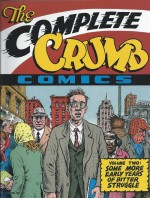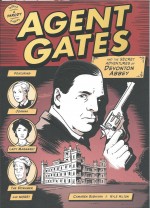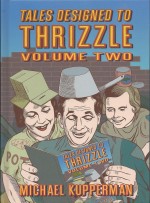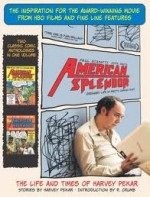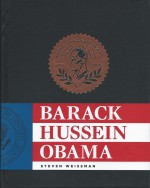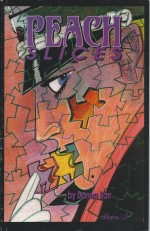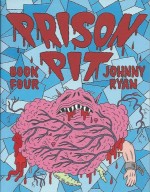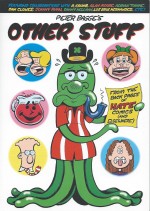
By Peter Bagge with R. Crumb, Alan Moore, Adrian Tomine, Dan Clowes, Johnny Ryan, Danny Hellman, Gilbert & Jaime Hernadez, Joanne Bagge & various (Fantagraphics Books)
ISBN: 978-1-60699-622-5
You probably know Peter Bagge as the fiery, wise-mouthed, superbly acerbic cartoonist responsible for incredibly addictive, sharply satirical strips about American life that featured in such wonderful magazines as Neat Stuff and Hate, his superbly strident Buddy Bradley stories or even his forays into the more-or-less comics mainstream with such works as DC’s Yeah!
But the graphic ridiculist also has a commercial impetus, whimsical nature, politically active side (as cartoonist and societal commentator for the Libertarian publication Reason) and a secret life outside comics.
Thus this glorious compendium of seldom-seen strips from a variety of publications has been compiled by Fantagraphics, in a (mostly) full-colour softcover collection stuffed with deliciously fluid drawings and razor-sharp polemic, broadly comedic or surreal observations and, as ever, sharply incisive, highly rational and deeply intimate questioning quandaries and observations.
Bagge’s oeuvre is skewering stupidity, spotlighting pomposity and generally exposing the day-to-day aggravations and institutionalized insanities of modern urban life and these strips, from such diverse sources as his own Hate Annuals, Hate Jamboree, Weirdo, El Rios, newspapers such as The Stranger and LA Times as well as publications like Magnet Magazine, Spin, Razor, Discover, Details, Toro, Vice and software company Adobe’s website from the 1980s to the present, offer a fascinating insight into his world, working as they do under the constraints of a client’s prerequisites…
They’re still all outrageously hilarious and powerfully effective though, even when filtered through the lens of cartoon collaborators such as the sparkling pantheon featured here…
Following an extensive, detail-packed explanatory Introduction, the madness begins to unfold in a section collecting all the adventures of classy, racily moderne young broad Lovey (first seen in Hate Annual #1, 2, 4 and 5 and The Stranger from 2000-2004) beginning with ‘Gender-Bending Hyjinx’ progressing to the gloriously distasteful ‘The Gaggle and the Gimp!’ before revealing ‘The Real André’ and indulging in ‘A Party to Forget’…
The music scene gets a wry shellacking in Rock ‘n’ Roll – covering material from 1995-2012 – which opens with a string of ‘Musical Urban Legends Presents’ single-pagers from Magnet including ‘Gnomes are Real’, ‘A Winning Formula’, ‘Dinner with Brian (Part One)’, ‘The Stuff of Genius’, ‘What Price Love?’, ‘Dinner with Brian (Wilson, that is) Part 2’, ‘Little Richard in “Ménage a Whah?!‒, ‘Kiss my Baby’ and ‘Start Spreadin’ the News’ whilst ‘Man with a Vision’ lampoons youthful ambition in a smart strip which originally debuted in Spin.
The chapter then closes with a trio of Beach Boys-themed bad vibrations as ‘Murry Wilson: Rock ‘n’ Roll Dad’ appals in ‘Turn Back the Hands of Time’ (co-created with Dana Gould), meets Charles Manson in ‘Helter Skelter, My Ass’ and treats his son ‘The Meal Ticket’ just as you always suspected he did…
The promised Collaborations cover the period 1996-2002 and mostly come from Hate, finding Bagge working in various roles such as scripter of ‘Me’ illustrated by Gilbert Hernandez, and illustrator of ‘Go Ask Alice’, written by Alice Cooper and appearing in Spin.
‘Shamrock Squid: Autobiographical Cartoonist!’ was drawn by Adrian Tomine, ‘The Hasty Smear of my Smile…’ exposing the sordid life of the Kool-Aid Man was written by Alan Moore & inked by Eric Reynolds, whilst ‘Life in these United States’ was rendered by Daniel Clowes and debuted in Weirdo.
Iconoclastic Johnny Ryan drew ‘Dildobert Joins the Al-Qaeda’, the autobiographical delight ‘What’s in a Name?‘ was illustrated by Danny Hellman, sordid strip spoof ‘Caffy’ was drawn by R. Crumb, ‘Shamrock Squid in Up the Irish!’ was inked by Eric Reynolds and the hilarious ‘The Action Suits Story’ was illustrated by Jaime Hernandez.
There are a number of strips throughout the volume gleefully dissing long-time inker and collaborator Jim Blanchard in such cruel and revelatory epics as ‘Backyard Funnies’ written & pencilled by Reynolds, ‘Don’t Knock It If You Haven’t Tried It’ (written & drawn by Pat Moriarty), ‘Bleachy Blanchard’ written & drawn by Kevin Scalzo, and ‘Harassed Citizen’ written & drawn by Rick Altergott. There’s also the scathing solo effort ‘That Darn Blanchard’ in the introduction pages too…
“True†Facts covers educational (sort of) features such as biographies of scientists from Discover Magazine in 2009. These highlight Robert Brown in ‘I’ll Second That Motion’, Wallace “Gloomy Gus†Carothers in ‘It’s a Wonderful Legacy’, reveal what ‘Mendeleyev Predicts!’, heralds Joseph Priestly as ‘Phlogiston’s Last Champion!’, details Major Walter Reed’s ghastly experiments in ‘Yellow Fever Fever!’ and celebrates ancient Moslem savant Taqi al-Din in ‘Oh, What a Spin I’m In!’
From 1998 ‘So Much Comedy, So Little Time’ (from Details) exposes the festival circuit whilst the autobiographical ‘East Coast, West Coast, Blah, Blah, Blah…’ came from Road Strips in 2005 and ‘Partying with the “Dickster‑ revealed a truth about Vice President Cheney in a 2007 strip from the LA Times… as did radio expose ‘At the End of the Day…’
‘Stuff I Know about Belgium, by Some Dumb American’, which originated in El Rios in 2010, the savagely self-excoriating ‘What Was Wrong With Us?’ from 2002, the incisive ‘Game Day with the Quarterback’s Wife’ (Toro, 2004) and ‘The Expert’ (Vice, 2006) all explore humanity’s foible-besmirched mundanity, and this collection more or less concludes with a series originally shown as entertainment content on Adobe’s homepage in 2000 before being reprinted in Hate Annual #6.
Restored and re-coloured by Bagge’s most consistent collaborator – his wife Joanne –
The Shut-Ins follows the slow seduction and fall of computer illiterates Chet and Bunny in ‘Meet the Shut-Ins’, ‘Meet Santiago’, ‘Pretty Flowers’, ‘Make the World Go Away’, ‘The Great Indoors’, ‘Withdrawal Symptoms’, ‘Life Among the Earthlings’, ‘A Short-Lived Recovery’, ‘Our Babies’, ‘Irrigation Blues’, ‘The Funeral’, ‘No Good for the ‘Hood”, ‘The Meg Ryan Factor’, ‘Oh, What a Night!’, ‘Taking Stock’, ‘Slowly He Turned’, ‘Rich, Rich, Rich!’, ‘Dot Com Casualties’ and ‘Can I Interest You in Some Fairy Dust?’
Even after all that the cartoon craziness goes on as the designers squeeze in two more lost classics –‘Crazy Exes’ from Spanish GQ in 2000 and, on the back cover, ‘Good Ol’ Posterity’ from Artforum…
Challenging, hilarious, wonderfully shocking and always thought-provoking, Other Stuff in another superbly engaging and entertaining book from a brilliantly inspired social commentator and inquisitor; impassioned, deeply involved and never afraid to admit when he’s confused, angry or just plain wrong. This wonderful use of heart, smarts and ink is one more reason why cartooning is the most potent mode of expression we possess.
© 2013 Peter Bagge, except as noted on the strips themselves. All rights reserved.

